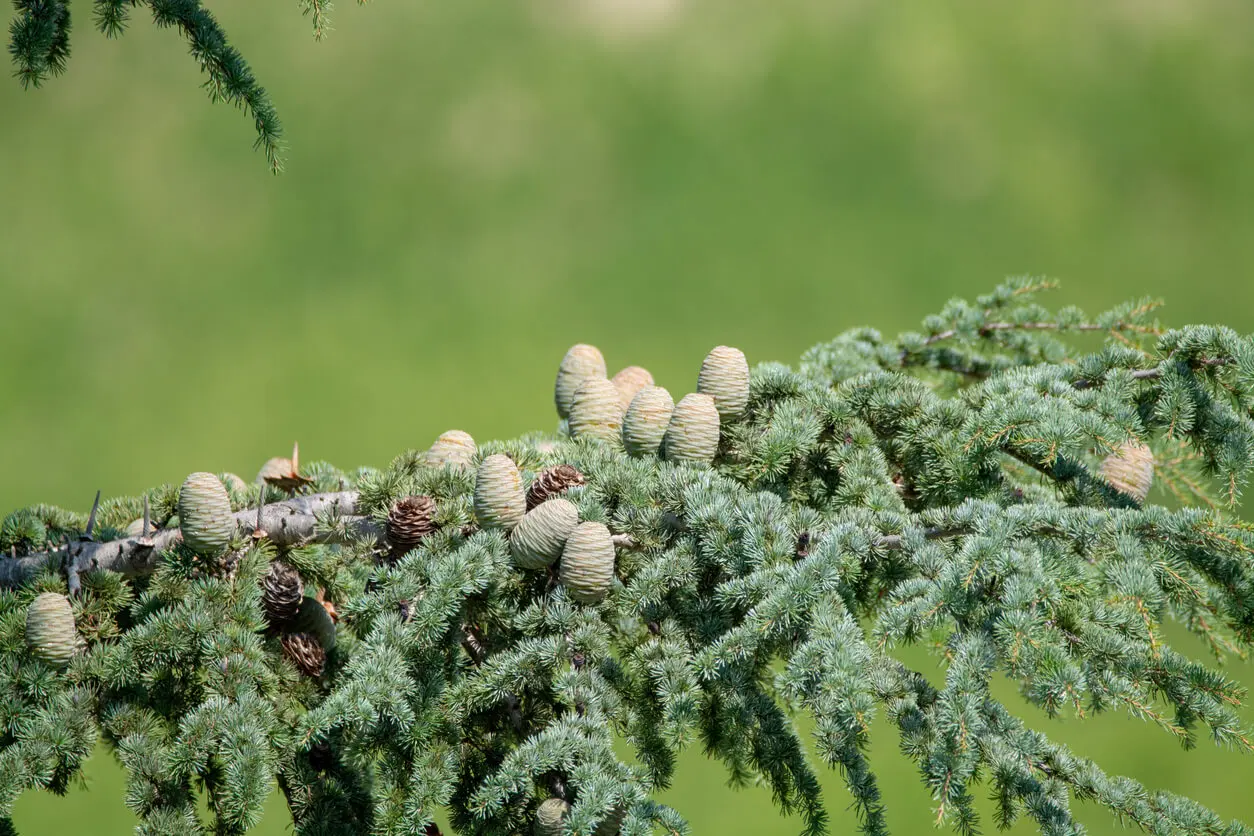Himalayan Cedarwood Essential Oil: Benefits and Applications


Reviewed and approved by the pharmacist Franciele Rohor de Souza
Himalayan cedarwood essential oil is a product obtained via a steam distillate method, with parts of the wood of the tree Cedrus deodara. It’s appreciated in aromatherapy, as it acts as a calming, antimicrobial, and decongestant element.
In Ayurvedic medicine and traditional Chinese medicine it’s often used to reduce anxiety and stress and improve respiratory health. In addition, it contributes to skincare and facilitates some household chores. Want to know more about its uses and benefits? Read on!
Benefits and applications of Himalayan cedarwood essential oil
Before getting to know the uses of Himalayan cedarwood essential oil in detail, it’s worth highlighting its main active compounds. As compiled by Sandeep Kumar of Anna University in India, it contains the following:
- Caryophyllene: 3.14 %
- α-terpineol: 30,2 %
- Linalool: 24,47 %
- Limonene: 17,01 %
- Anethole: 14,57 %
- Eugenol: 2,14 %
Among other things, it contains lignans, phenolic sesquiterpene himasecolone, and isopimaric acid. Let’s have a detailed look at its applications in health, skincare, and home use.
Read also: Copaiba Oil: Uses, Benefits, and Contraindications
Medicinal uses of Himalayan cedarwood essential oil
Due to its anti-inflammatory, antioxidant, soothing, and antimicrobial potential, Himalayan cedarwood essential oil has several applications at a medicinal level. However, it should be borne in mind that most of them come from popular literature and lack supporting research.
To date, most studies have been done in the laboratory and on animals. Regardless, the findings are promising.
Arthritis
Topically and combined with a carrier oil, Himalayan cedar oil is used as a remedy to improve arthritis symptoms. In particular, its application via massages helps to reduce inflammation and joint stiffness.
In this regard, a study in rats reported in the Research Journal of Pharmaceutical, Biological, and Chemical Sciences reported that Cedrus deodara extracts have anti-arthritic properties, attributed to their alkaloids, flavonoids, glycosides, phenolic compounds, saponins and proteins.

Respiratory infections
Some of the traditional uses of this ingredient are related to respiratory health. It’s often used as an adjuvant to reduce the symptoms of bronchitis, flu, colds, among other upper respiratory tract infections.
This is largely explained by its antispasmodic, expectorant, and anti-inflammatory effect, which helps to clear the airways. For now, these effects are supported only by anecdotal evidence. Scientific studies are needed to corroborate it completely.
Mood
In Ayurvedic medicine, Himalayan cedarwood essential oil is used in aromatherapy to relax the nervous system and reduce states of stress and anxiety. Its volatile compounds have a relaxing effect that helps to calm body and mind.
In this regard, research in rodents reported in The Korean Journal of Physiology & Pharmacology reported that some compounds isolated from Cedrus deodara – specifically 3,4-dimethoxyphenyl and furan-2,5-dione (BDFD) – had an antidepressant effect.
This was associated with increased levels of serotonin and noradrenaline in the brain, hormones that are linked to the regulation of sleep, mood, and pain. Evidence in humans is needed to prove these effects.
Dermatitis and eczema
Himalayan cedarwood essential oil is used topically as an adjunct for skin with eczema and dermatitis. Its anti-inflammatory and antimicrobial properties aid in the reduction of scaly, irritated skin.
In rodent research shared in Clinical, Cosmetic and Investigational Dermatology, an Ayurvedic herbal treatment containing Cedrus deodara exhibited anti-inflammatory potential which is useful in combating atopic dermatitis. This was attributed to its abundant phytochemical content.
Cosmetic uses
In natural cosmetics, Himalayan cedarwood essential oil has applications for both skin and hair. Its concentration of antioxidants is believed to protect the dermis and reduce the risk of premature aging.
However, there are no studies to prove it.
Even so, in various cultures, especially in India and China, it’s used for the following purposes:
- A natural deodorant
- The prevention of bacterial and fungal infections
- Elimination of flakes or dandruff on the scalp
- The reduction of acne pimples and prevention of scars
- Natural skin firming – it’s believed to help reduce cellulite
- Prevention of hair loss. It’s applied along with a carrier oil (coconut, almond, castor, etc.) through circular massages.
Uses of Himalayan cedar essential oil in the home
Beyond its uses in natural medicine and cosmetics, Himalayan cedarwood essential oil has been used as an adjunct to household cleaning and disinfection. Here are its main uses:
- Odor eliminator. Its fresh scent helps to deodorize areas and reduce bad odors.
- Mosquito repellent. Dissolve 15 drops in 100 milliliters of water or in a spoonful of carrier oil to prevent mosquito bites. In addition, if put in an aroma diffuser it helps to prevent these insects from entering the home.
- Multipurpose disinfectant. Add 20 to 30 drops of the oil in a spray bottle with 200 milliliters of water. The liquid can then be sprayed on countertops, furniture, and other surfaces requiring disinfection.
- Stain remover. It can be added to regular detergent to facilitate the removal of sweat stains.
- Mold and mildew remover. Its antifungal properties help stop the growth of mold and mildew on various household surfaces. Simply rub the product with a cloth or sponge.

Is this essential oil safe?
To date, studies on Himalayan cedar essential oil are very limited and currently record no side effects. It’s considered safe when used in aromatherapy, even for pregnant or breastfeeding women.
However, topical application should be carried out with caution. While it doesn’t usually cause adverse reactions, it’s best to do a patch test before applying it in its entirety.
This consists of applying a small amount of the product (always diluted in water or carrier oil) to a small area of the skin. If after 2 or 3 hours there’s no irritation, itching, or redness, it can be used without any problems.
Like other essential oils, Himalayan cedarwood oil shouldn’t be ingested orally. There’s a risk of intoxication, mucosal irritation, and other side effects after ingestion.
Natural remedies with Himalayan cedar essential oil
This oil is often combined with other essential oils to enhance its properties. However, keep in mind that these remedies are merely a complement and don’t replace medical treatments.
- Stress: Combine equal parts of Himalayan cedar essential oil with orange oil and lavender oil. Then introduce them the diffuser.
- Insomnia: Mix equal parts of cedarwood oil with lavender and frankincense. Diffuse the aroma in the room 30 minutes before going to bed.
- Facial tonic: Pour 3 to 5 drops of Himalayan cedarwood essential oil with 200 milliliters of witch hazel water without alcohol. It is ideal for toning, cleansing and reducing excess oil production.
- Coughs and congestion: Combine 5 drops of cedarwood oil with 10 grams of coconut or almond oil. Then rub it on the chest, neck, and back.
- Natural repellent: Combine 5 drops of cedar oil with 10 milliliters of jojoba oil. Then, apply on the areas sensitive to bites.
Read more here: What Are Essential Oils and How and Why Do They Work?
What to remember about this essential oil?
Despite its extensive history as an Ayurvedic remedy, Himalayan cedarwood essential oil hasn’t been sufficiently studied. Many of its applications are supported only by anecdotal data, so its use should be cautious.
In general, applied in aromatherapy or topically, it’s safe and well tolerated. It’s usually useful in cases of congestion, coughs, skin desquamation, anxiety, stress, and joint ailments.
It isn’t recommended for oral consumption. If in doubt, consult with the herbalist or directly with your doctor.
All cited sources were thoroughly reviewed by our team to ensure their quality, reliability, currency, and validity. The bibliography of this article was considered reliable and of academic or scientific accuracy.
- Kumar, Sandeep. (2019). Himalayan (Himachal region) cedar wood (Cedrus deodara: Pinaceae) essential oil, its processing, ingredients and uses: A review. 8. 2228-2238.
- Chandur, Uma & Shashidhar, Shrusti & Chandrasekar, S.B. & Rao, M.. (2011). Studies of preliminary phytochemical and anti-arthritic activity of heart wood of Cedrus deodar (Roxb.). Research Journal of Pharmaceutical, Biological and Chemical Sciences. 2. 654-660.
- Kumar N, Dhayabaran D, Nampoothiri M, Nandakumar K, Puratchikody A, Lalani N, Dawood K, Ghosh A. Atypical Antidepressant Activity of 3,4-Bis(3,4-Dimethoxyphenyl) Furan-2,5-Dione Isolated from Heart Wood of Cedrus deodara, in Rodents. Korean J Physiol Pharmacol. 2014 Oct;18(5):365-9. doi: 10.4196/kjpp.2014.18.5.365. Epub 2014 Oct 17. PMID: 25352754; PMCID: PMC4211118.
- Balkrishna A, Verma S, Sakat S, Joshi K, Solleti SK, Bhattacharya K, Varshney A. Comprehensive Phytochemical Profiling of Polyherbal Divya-Kayakalp-Vati and Divya-Kayakalp-Oil and Their Combined Efficacy in Mouse Model of Atopic Dermatitis-Like Inflammation Through Regulation of Cytokines. Clin Cosmet Investig Dermatol. 2022 Feb 23;15:293-312. doi: 10.2147/CCID.S342227. PMID: 35237058; PMCID: PMC8882669.
This text is provided for informational purposes only and does not replace consultation with a professional. If in doubt, consult your specialist.








